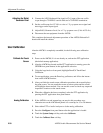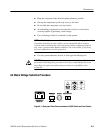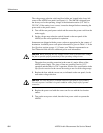
Maintainence
6–2
AM700 Audio Measurement Set Service Manual
2. Surround the instrument with polyethylene sheeting to protect the finish.
3. Cushion the instrument on all sides by tightly packing dunnage or urethane
foam between the carton and the instrument. Allow three inches on all sides
for cushioning.
4. Seal the carton with shipping tape or an industrial stapler.
Static-Sensitive Components
This instrument contains electrical components that are susceptible to damage
from static discharge. Static voltages of 1 kV to 30 kV are common in unpro-
tected environments. Table 6–1 shows the relative static discharge susceptibility
of various semiconductor classes.
Table 6–1: Static susceptibility
Relative Susceptibility Levels
1
Voltage
MOS and CMOS 100 – 500 V
ECL 200 – 500 V
Schottky Signal Diodes 250 V
Schottky TTL 500 V
HF Bipolar Transistors 400 – 600 V
JFETs 600 – 800 V
Linear microcircuits 400 – 1,000 V (est.)
Low-Power Schottky TTL 900 V
TTL 1,200 V
1
Voltage equivalent for levels (voltage discharged from a 100 pF capacitor through a
100 W resistance).
Observe the following precautions to avoid damage:
H Minimize handling of static-sensitive components.
H Transport and store static-sensitive components or assemblies in their
original containers, on a metal rail, or on conductive foam. Label any
package that contains static-sensitive components or assemblies.
H Discharge the static voltage from your body by wearing a wrist grounding
strap while handling these components. Servicing static-sensitive assemblies
or components should be done only at a static-free work station by qualified
personnel.
H Nothing capable of generating or holding a static charge should be allowed
on the work station surface.


















